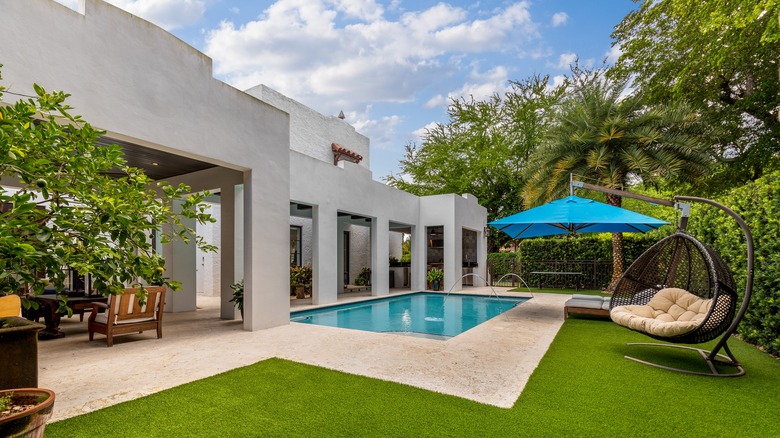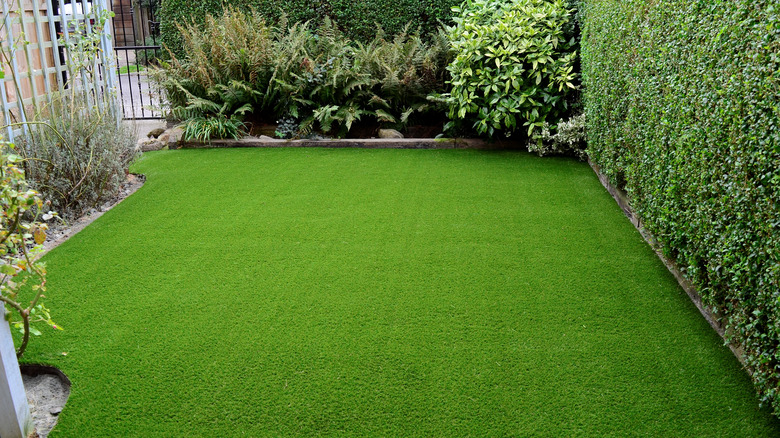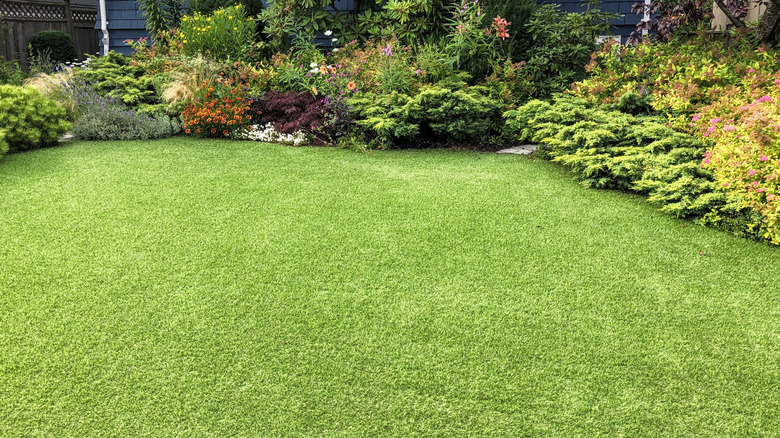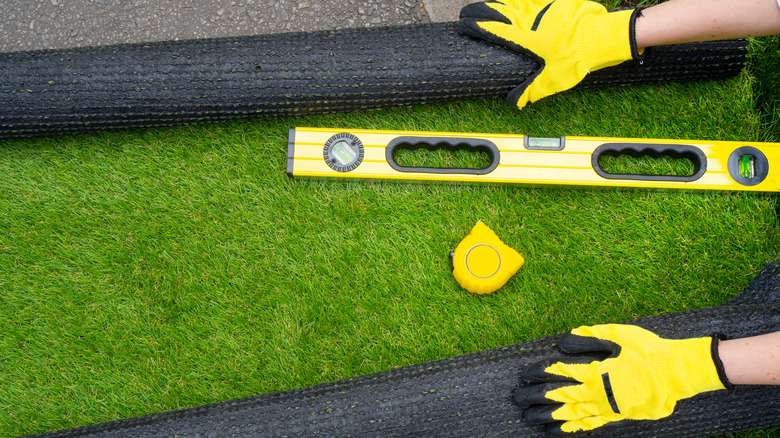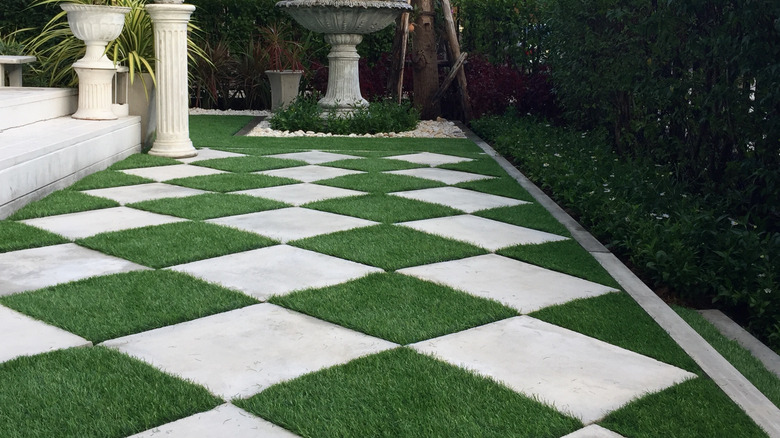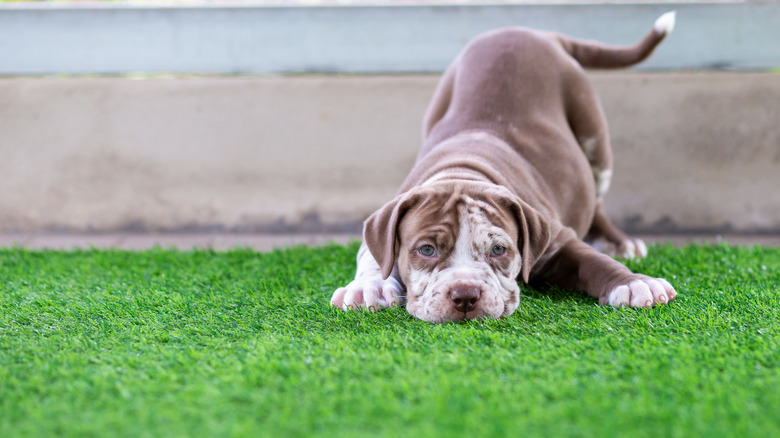Pros And Cons Of Installing Artificial Grass On Your Property
Having a gorgeous, lush green lawn is a source of pride and joy for many. However, real grass is very finicky. It takes a lot of labor to cut the grass and skill to prevent the lawn mower from creating bald patches. You have to take extensive preventative measures to prevent weeds from growing and ruining the appearance of your lawn, too. Finally, grass maintenance requires a lot of water, and if you live in a climate without a lot of rain, that amount of water can be very pricey.
This is why many people opt for artificial grass. When you think of artificial grass, you probably think of turf, which is shiny and often plastic-y looking. Modern artificial grass, though, is designed to be much more natural-looking. As Heavenly Green notes, turf is meant to be short and tough, able to withstand the rough movements of a sports game. Artificial grass for lawns is longer and has a more natural, fluffy appearance. Before installing artificial grass, you should consider the advantages and disadvantages and how they affect your lifestyle.
What is artificial grass?
Before installing artificial grass, you should probably know what it actually is. There are plenty of artificial grass manufacturers to choose from, and all of them have different processes and materials. Family Handyman says there are three different materials used to make artificial grass: nylon, polyethylene, and polypropylene.
Polypropylene is the most inexpensive option, but it is also not that durable. If you've ever been golfing, you've probably seen polypropylene artificial grass on putting greens. Nylon is the priciest material, and opposite to polypropylene, it's very durable. In fact, some people may find it to be too durable and stiff for pets or children to play on. Polyethylene is somewhere between the two in durability and price. It's less durable and stuff than nylon. It provides a softer surface to walk and play on (soft enough to be barefoot), although perhaps not as soft as polypropylene, but more durable.
Pro: Easier to maintain
One of the most obvious pros to installing artificial grass is how easy it is to maintain. This lack of required maintenance also significantly reduces regular lawn care expenses. According to Artificial Grass Liquidators, real grass needs an average of 55 gallons of water per square foot per year to keep it alive and healthy. While natural rainfall is sufficient in some climates, it isn't in more arid and hot areas.
Similarly, you don't have to worry about other maintenance duties, like fertilizing your lawn, laying down preventive weed control products or removing existing weeds, spraying pest control, and other regular lawn chores. Artificial grass means you can sell your lawn mower, stop buying expensive lawn care products, and more. Having artificial grass means you're saving lots of time and money every month.
When properly cared for, artificial grass can last up to 20 years. The maintenance required for artificial grass is significantly less than the real stuff. US Turf San Diego lists basic chores as picking up any pet waste or debris and cleaning up any spills or stains. Once in a while, use a garden hose to clean off any surface dirt, pollen, or anything else that could accumulate on top. You can fluff up the artificial blades by using a turf brush, going against the grain for a fuller look.
Con: Expensive to install
While artificial grass significantly reduces overall lawn maintenance costs by cutting back on water and labor, it is quite expensive upfront. It will also be costly to reinstall, but that only needs to be done every 20 years if properly cared for (per US Turf San Diego).
Installation costs will vary depending on where you're installing your artificial grass. For example, a small patch in your backyard will be significantly cheaper than a whole lawn. LawnStarter says that, with labor and materials included, artificial grass installation can cost anywhere from $5.50 to $18.75 per square foot but averages around $12.33. A 500-square-foot yard has an average installation cost of $6,165.
Besides the size of your installation, other factors that influence price are how much the installers charge, the brand of grass purchased, and, as mentioned earlier, the material chosen. Nylon is the most expensive, costing $5.05 to $5.83 per square foot. Polyethylene is much cheaper, at $2.55 to $3.85 per square foot. The cheapest option is polypropylene, at $1.90 to $6.75 per square foot.
Pro: Customizable design options
Another fun benefit of choosing artificial grass over natural grass is how customizable it is in terms of lawn design. Since real grass needs to be in certain growing conditions, adding fun designs to your lawn can be difficult. Even if you're able to, real grass can grow overtop of stone, and maintenance becomes even more of a hassle.
Artificial grass has no such limitations. As Install-It Direct notes, artificial grass lawn design options are endless. You can use it just for pavers or combine a full lawn with lots of lush natural plants to help blend it in. There are lots of interesting artistic design options as well. For example, you can combine artificial grass with garden stones to create modern or whimsical designs and pathways. You can create groovy or retro patterns by simply cutting the edge on a curve. As MegaGrass points out, you can also use it to create your own mini putting green!
Con: Pet maintenance
One concern you may have about your artificial grass is how safe it is for pets. Luckily, it is completely safe for pets to be on, says Courts & Greens. As a bonus, dogs can't dig into the artificial grass the way they can in natural grass. You also don't need to worry about harmful lawn treatments.
However, it still presents some challenges to pet owners. Artificial grass already has drainage holes, so it won't get soggy or waterlogged during rainfall. Pet urine will drain through these holes perfectly fine. Feces, however, won't break down the way it does in real grass. While you should be picking up pet waste on all lawns, there can be residue on artificial grass that won't break down or go away. All pet waste will leave behind unpleasant odors, too. For this reason, you'll need to hose off your artificial lawn much more frequently. If smells persist, you can use a vinegar and water solution to remove lingering odors.
